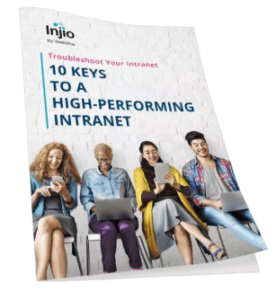New year, new you… same old workplace? In many organisations the workplace, both physical and digital, is still catching up with recent dramatic changes in how we work. A task made even more difficult by ongoing uncertainly about returning to the office and increased workforce volatility.
If your organisation is not already planning for these 2022 workplace trends, it’s going to be even harder to catch up.
1) Productivity anywhere
Mobile access to resources, collaboration spaces and the intranet will move beyond mere access to encompass stronger usability and a richer user experience. Particularly for frontline staff, the gap between PC and tablet/phone functionality will narrow. Organisations operating on a digital first model, leveraging intranets and digital workplaces to support remote working will continue to record lower turnover and stronger growth.
2) The continued domination of Microsoft Teams
As the duct tape holding together everyone’s meetings, file sharing and chat throughout the pandemic, Teams needs no introduction. It’s where a lot of us now spend our workday. The key now is how effectively we integrate other apps and platforms into Teams. Intranets, 3rd party apps like Salesforce & ServiceNow and other M365 apps like Outlook and Planner are critical to keeping the tools employees need at their fingertips. Messaging extensions to highlight content from other platforms is also on the rise.
3) More automation, less aggravation
The average office worker spends over 3 hours per day on tasks that could easily be automated. Harvard Business Review estimates that up to 65% of the tasks that a manager currently does has the potential to be automated by 2025. From obvious manual processes like HR requests and data entry to more nuanced areas like helpdesk support and onboarding, automation is likely to be the next big productivity driver for many organisations.
Remote working opportunities and renewed consideration of priorities has led to greater employee turnover. The need for a comprehensive onboarding program is paramount and automation enables consistent, efficient delivery, freeing managers to focus on the human aspects of welcoming a new team member.
4) Wellbeing as a central pillar
For years, employee wellbeing has been an afterthought: a gym voucher, decent coffee machine or stand-up desk ticking the box nicely. Employee wellbeing can no longer be tacked on to an existing HR strategy. It must inform every decision and encompass physical, emotional and social health for all staff, not just the ones with desks. In a recent survey 67% of Gen Z agreed that well-being benefits will be a priority for them in evaluating new job offers.
Leading organisations are providing a range of benefits to appeal to a broad range of staff via people-centric intranets: flexible company culture, mindfulness apps, learning & education, virtual exercise sessions and assistance for working parents.
Microsoft Viva will form a greater part of some organisations’ armoury, using wellbeing triggers to fight burnout:
• identifying potential issues with recommendations
• personal insights into time spent in meetings/email
• reminders to make time for learning & building your network
5) Intranets the central hub for hybrid work
Modern intranets will continue to expand and deliver broader capabilities to support remote & hybrid work, from single sign-on access to HR and payroll systems to training and certification as well as social connection. The new breed of intranets is expanding into the digital workplace space, leveraging innovative new services from Microsoft such as Viva Learning, Insights and Teams Mesh. Intranets can help maximise adoption and ROI for these new technologies by providing structured access as well as context.
There are many other trends and areas of opportunity in the digital workplace such as AI-powered content, asynchronous collaboration and citizen development. It’s a dynamic space and we are excited to be part of an industry that is so integral to people’s daily lives. Want to talk with an expert about your plans and challenges? Contact Us Now.
This entry was posted in Digital Transformation, Digital Workplace. Bookmark the permalink.






